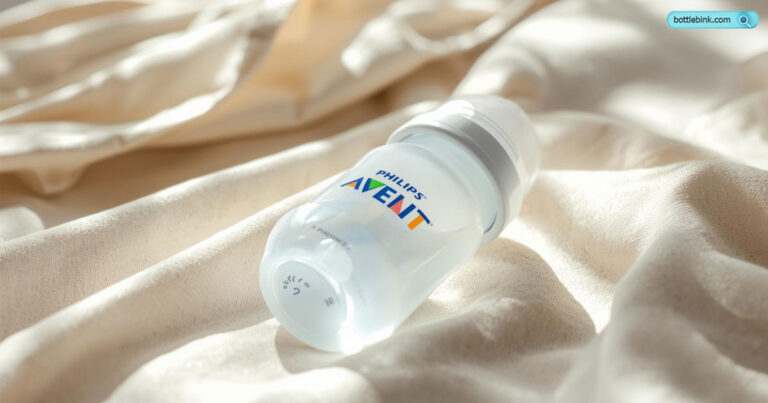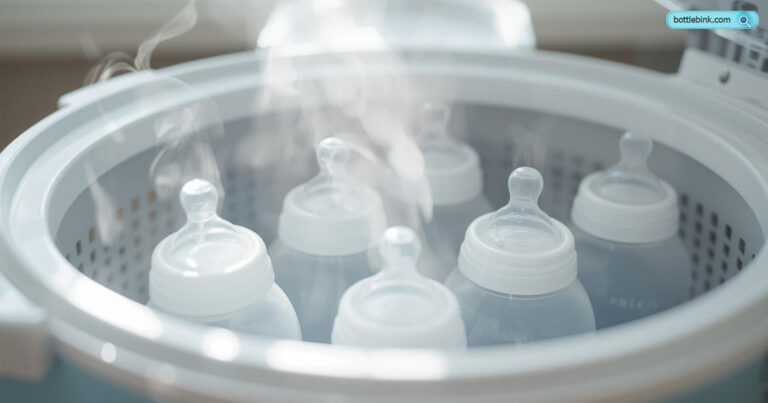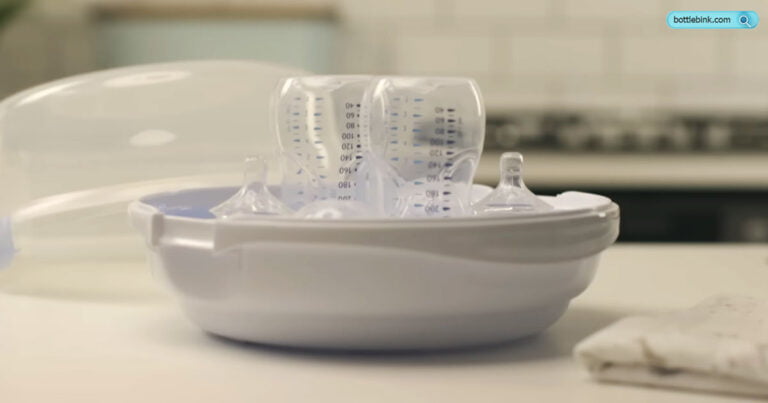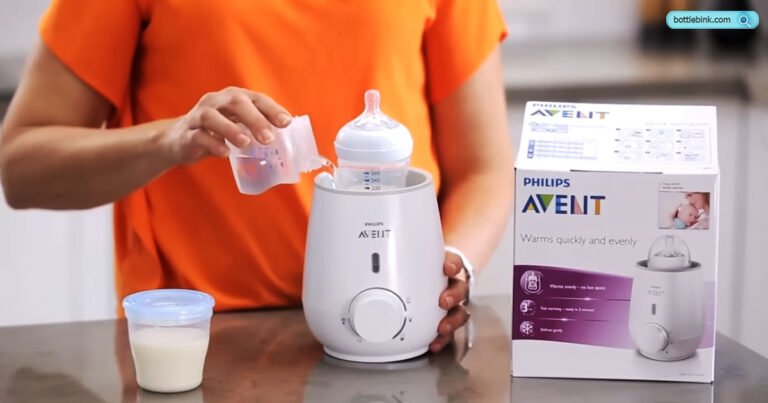How to Dry Baby Bottles: Quick Tips for Fast Drying
To dry baby bottles quickly, use a baby bottle sterilizer dryer, which dries the bottles rapidly after sterilizing. This electric bottle sanitizer with a built-in dryer operates like a hair dryer, ensuring fast drying.
Properly drying baby bottles is crucial to prevent bacteria growth and ensure hygiene. Introducing cleanliness in a baby’s feeding routine is pivotal for their well-being. A vital but often overlooked aspect is the drying process post-sterilization of baby bottles. Learning how to dry baby bottles effectively and efficiently is essential to maintain hygiene and ensure the safety of the baby.
Whether you opt for natural air drying methods or utilize specialized baby bottle sterilizer dryers, the process is indispensable for preventing bacterial growth. We will explore various techniques to effectively dry baby bottles after sterilization, ensuring optimal cleanliness and hygiene for your little one.
Choosing The Right Drying Rack
Choosing the right drying rack is essential for efficiently drying baby bottles after sterilizing. With the help of a baby bottle sterilizer dryer, you can ensure that your bottles are dried quickly and effectively, preventing bacteria growth and keeping your baby bottles clean and safe.
When it comes to drying baby bottles, choosing the right drying rack is essential to ensure a clean and hygienic environment for your little one. A good drying rack not only helps in keeping the bottles upright but also allows air circulation to speed up the drying process. Here are two key factors to consider when selecting the perfect drying rack for your baby bottles.
Consider Size And Capacity
The first thing to consider when choosing a drying rack is its size and capacity. Look for a drying rack that can accommodate all your baby bottles, bottle accessories, and other feeding essentials. A rack with multiple levels or adjustable parts can provide extra space, making it easier to dry not only the bottles but also breast pump parts, pacifiers, and nipples. A table is suitable for representing the information about the size and capacity of the drying rack.
| Rack Name | Size | Capacity |
| Dr. Brown’s Clean Steam Bottle Sterilizer | Compact | Up to 6 bottles |
| Baby Brezza Baby Bottle Sterilizer and Dryer | Spacious | Up to 8 bottles |
| Boon Drying Rack Grass Countertop | Compact | Up to 9 bottles |
| OXO Tot Space Saving Drying Rack | Space-saving | Up to 8 bottles |
| Papablic Baby Bottle Electric Steam Sterilizer and Dryer | Large | Up to 10 bottles |
Look For Draining System
The draining system is another important feature to consider when selecting a drying rack for your baby bottles. A good draining system ensures efficient water drainage, preventing the buildup of moisture and reducing the risk of bacterial growth. Look for a drying rack with a tray or bottom that collects excess water and allows it to drain away from the bottles.
This prevents the bottles from sitting in a pool of water, which can lead to unwanted bacteria formation. Aside from the tray or bottom, some drying racks also come with additional features such as removable drying pegs or adjustable arms. These features allow you to customize the rack to accommodate different bottle sizes and shapes, maximizing the drying space and ensuring all parts of the bottles are exposed to air for proper drying.
By carefully considering the size and capacity of the drying rack, as well as the efficiency of the draining system, you can find the perfect drying rack that meets your needs and helps ensure your baby bottles are dried thoroughly and hygienically.
So, choose wisely and enjoy the convenience and peace of mind that comes with a well-chosen drying rack for your baby bottles. Remember, maintaining cleanliness and proper drying of baby bottles is essential for your baby’s health and well-being.

Disassembling And Cleaning
Properly disassembling and cleaning baby bottles is essential to ensure they are free from any milk residue, bacteria, or other contaminants. This process involves separating different parts of the bottle and thoroughly cleaning them to maintain hygiene. Here’s how to effectively disassemble and clean baby bottles:
Separate Bottle Parts
When disassembling the baby bottle, it’s crucial to separate all the parts for a thorough cleaning. Unscrew the bottle cap and remove the nipple, collar, and any other detachable components. Carefully inspect each part to ensure there are no hidden remnants of milk or formula. Separating the bottle parts allows for better access during the cleaning process.
Clean Thoroughly
After separating the bottle parts, it’s time to clean them thoroughly. Use a bottle brush to scrub the inside of the bottle, paying special attention to any hard-to-reach areas. Utilize hot, soapy water to eliminate any lingering residue. Similarly, the nipple, collar, and any other detachable components should be thoroughly cleaned using a bottle brush and soapy water to ensure no traces of milk or formula remain.
Once all parts have been cleaned, rinse them under running water to remove any soap residue. After rinsing, sterilize the bottle parts to kill any remaining bacteria and ensure they are completely safe for your baby to use.
Air Drying The Bottles
When it comes to drying baby bottles, using a baby bottle sterilizer dryer is the fastest way. The built-in dryer quickly dries the bottles after sterilizing, preventing bacteria growth and ensuring they are ready for use.
Place Bottles Upside Down
After washing the baby bottles thoroughly, place them upside down on a clean dish towel or a designated bottle drying rack. This helps the excess water to drip out and prevents any pooling inside the bottle, ensuring proper drying.
Allow Sufficient Time
Ensure you allow enough time for the baby bottles to air dry completely. Don’t rush this process, as any remaining moisture may increase the risk of bacterial growth. To speed up the drying process, you can gently shake the bottle to remove excess water before placing it on the rack.

Using A Sterilizer For Drying
Drying baby bottles can be made easier by using a baby bottle sterilizer with a built-in dryer. The electric sanitizer quickly dries the bottles after sterilizing, preventing bacteria growth and ensuring they are ready to use. Another method is to roll a paper towel and insert it into the bottle to absorb moisture.
Using a Sterilizer for Drying When it comes to drying baby bottles, using a sterilizer can be a quick and efficient method. Sterilizers not only sanitize the bottles but also have a built-in drying feature that ensures the bottles are completely dry before use. This is important to prevent bacteria growth and maintain the cleanliness of the bottles.
Follow Manufacturer’s Instructions When using a sterilizer for drying baby bottles, always follow the manufacturer’s instructions. Each sterilizer may have specific guidelines on how to use the drying function effectively. This ensures that the bottles are dried thoroughly and ready for use.
Ensure Bottles are Dry Before Use Before using the dried bottles, it is crucial to double-check that they are completely dry. Any remaining moisture can lead to bacterial growth, so it’s essential to ensure the bottles are dry before giving them to your baby. A simple way to check if the bottles are dry is by shaking them and listening for any water droplets. If you hear any noise, it means the bottles are not yet fully dry.
Here are a few additional tips to help dry baby bottles effectively using a sterilizer:
1. Properly Load the Sterilizer: Follow the instructions on how to load the sterilizer correctly. Make sure the bottles are placed in an upright position to allow the hot air to circulate and dry them evenly.
2. Remove Excess Water: Before placing the bottles in the sterilizer, ensure there is no excess water inside. Shake them gently to remove any water droplets that may be present.
3. Utilize the Drying Cycle: Many sterilizers have different settings, including specific drying cycles. Select the appropriate setting to ensure the bottles receive enough heat to dry them thoroughly.
4. Ventilation: Proper ventilation is essential for effective drying. Ensure that the sterilizer is placed in an area with good air circulation to allow the moisture to dissipate quickly.
In conclusion, using a sterilizer for drying baby bottles is a convenient and efficient method. By following the manufacturer’s instructions and ensuring the bottles are completely dry before use, you can maintain a clean and safe environment for your baby.
Storing Dried Bottles Safely
To safely store dried baby bottles, use a baby bottle sterilizer dryer for quick drying after sterilizing. It effectively eliminates moisture and prevents bacteria growth, ensuring bottles are completely dry and ready for storage. Additionally, a simple trick for drying bottles is to insert a rolled paper towel to absorb moisture and prevent residue.
Use A Clean Container
When it comes to storing dried baby bottles safely, using a clean container is of utmost importance. After thoroughly drying the bottles, you should place them in a container that is clean and free from any dust or dirt. This will help prevent any contamination and keep the bottles safe for use.
Avoid Direct Sunlight And Dust
To ensure the safety of your baby bottles, it is crucial to avoid exposing them to direct sunlight and dust. Sunlight can cause the bottles to degrade and lose their clarity, while dust can contaminate the bottles and make them unsuitable for use.
When storing the dried baby bottles, find a cool and dry place away from direct sunlight. Direct sunlight can not only degrade the bottles but also increase the chances of bacterial growth. Therefore, it’s important to choose a storage location that is away from any windows or areas where sunlight can directly reach the bottles.
Along with avoiding direct sunlight, it’s equally important to protect the bottles from dust. Dust particles can settle on the bottles and pose a risk of contamination. To prevent this, you can use a clean, breathable cover to keep the bottles safe from dust. This will ensure that your baby bottles remain clean and ready for use when needed.
FAQs For How To Dry Baby Bottles
How Do You Dry Baby Bottles Quickly?
To dry baby bottles quickly, use a baby bottle sterilizer dryer. It’s an electric bottle sanitizer with a built-in dryer that dries the bottles quickly after sterilizing. It’s important to dry bottles completely to prevent bacteria growth. You can also insert a rolled paper towel three-fourths of the way into the bottle to absorb moisture.
Condensation in the bottles is normal but avoid drying bottles with a cloth as it can transfer bacteria.
Do Baby Bottles Have To Be Completely Dry?
Yes, it is necessary to completely dry baby bottles before putting them away. Drying bottles helps prevent bacteria growth and is an essential part of the cleaning process. You can use a baby bottle sterilizer dryer or insert a rolled paper towel to absorb moisture and speed up drying.
How Do You Dry Out Bottles?
To dry out bottles, tightly roll a paper towel and insert it three-fourths of the way into the bottle. The paper towel will absorb the moisture. Leave some towel sticking out at the top to pull it out when the bottle is dry.
This trick works like magic.
Is Condensation In Baby Bottles Ok?
Condensation in baby bottles is normal and nothing to worry about. The water inside the bottle is sterile, so there is no need to dry the bottle. Drying bottles with a cloth can transfer bacteria, so it is best to leave them as they are after sterilizing.
Conclusion
Drying baby bottles is an essential part of the cleaning process to prevent bacteria growth. One effective way to dry baby bottles quickly is by using a baby bottle sterilizer dryer. This electric bottle sanitizer not only sterilizes the bottles but also has a built-in dryer that functions like a hair dryer, ensuring quick and efficient drying.
Additionally, rolling a paper towel and inserting it into the bottle can also help absorb moisture and prevent residue buildup. Remember to dry the bottles completely before storing them to maintain cleanliness.






